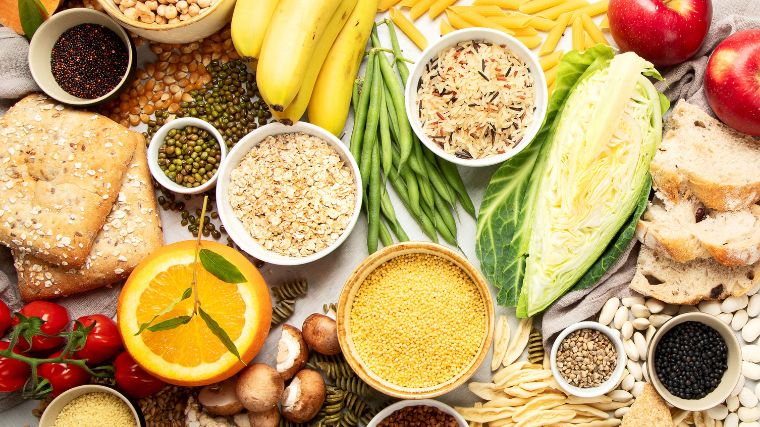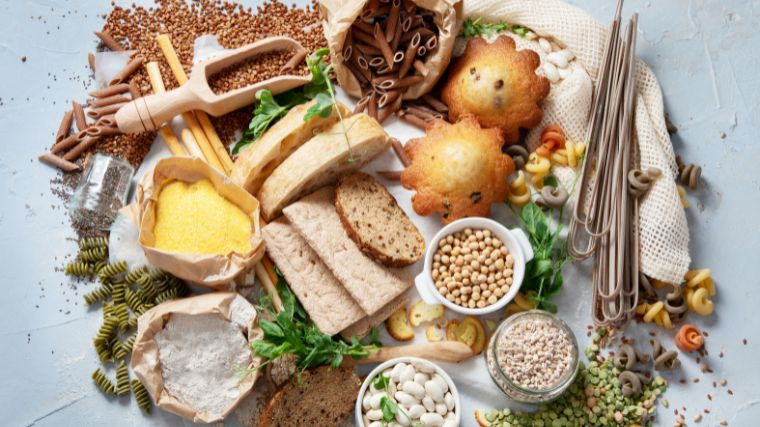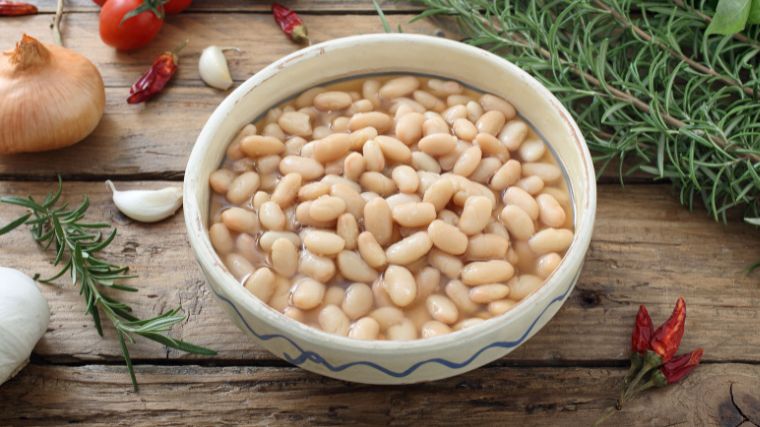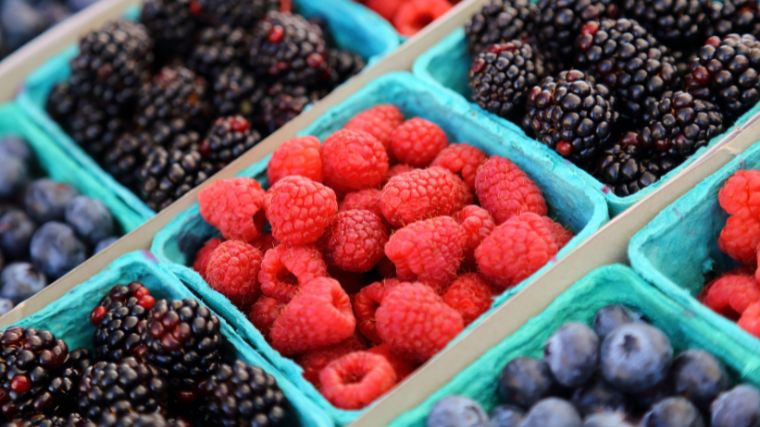If you’re new to learning about nutrition and fitness, you may understandably question the phrase healthy carbs. The low-carb era of diet culture has left its mark. There could be medical for you to reduce your carb intake. But when it comes to any type of fitness goal — fat loss included — carbohydrates are not your enemy.
Carbs are an energy source and one of the three macronutrients your body needs (the other two are protein and fat). There are two main types of carbohydrates: simple carbs and complex carbs. Simple carbs are not unhealthy, but complex carbs may pack more health benefits. Both types supply vital energy for workouts and play a part in gaining strength and muscle mass, sustaining endurance, and recovering from exercise.

Let’s get into the science behind healthy carbs — what they are, how they can benefit your digestive, metabolic, and cardiac health, your training goals, and all the best food sources to choose from.
Editor’s Note: The content on BarBend is meant to be informative in nature, but it should not be taken as medical advice. When starting a new training regimen and/or diet, it is always a good idea to consult with a trusted medical professional. We are not a medical resource. The opinions and articles on this site are not intended for use as diagnosis, prevention, and/or treatment of health problems. They are not substitutes for consulting a qualified medical professional.
What Are Healthy Carbs?
When faced with all the information and sources of carbohydrates it can be tough to narrow down the facts. No food is inherently good or bad. But if you have specific fitness goals or are looking to improve or maintain your overall health, the types of foods you choose to eat will have an impact on your body and how you feel.
Sure, if the word carbs calls to mind delicious, oily, salty french fries, that’s not something you’re going to want to eat in high quantities every single day. But there is plenty of space in a healthy diet for moderate amounts of everything you enjoy. Even if a food isn’t necessarily nutrient-dense, it may still play a role in your life culturally or emotionally, and these are important factors of a sustainable healthy lifestyle. (1)

[Read More: Nutrition for Athletes — How to Eat for Muscle and Performance]
Bearing this in mind, you can define healthy carbs as nutrient-rich carb sources that are minimally processed whole foods. Healthy carbs will give you energy for workouts and everyday life, support your metabolic and cardiac health, and are a key piece of your daily macronutrient puzzle.
Types of Healthy Carbs
The first type of carbs that may come to mind with the bad reputation they got from diet culture are simple carbs. “Simple” refers to the number of molecules in the carb — simple carbs are made from one or two sugar molecules and complex carbs are made of three or more. (2)
Simple carbs will spike your blood sugar and digest rapidly. Processed sugary foods fall under this category, but so do whole foods like fruit and white rice.
Complex carbs are digested slowly and will gradually impact your blood sugar rather than spiking it. (2) Healthy whole food sources of complex carbs include whole grains, legumes, and vegetables. Complex carbs can be further broken down into categories of starches, insoluble fibers, and soluble fibers. (2)
Though some fruits are considered simple carbs, fruits like apples and berries contain fiber and can be considered complex.
Starchy complex carbs come from plant-based foods like sweet potatoes, wheat, chickpeas, and whole grain pasta. Insoluble fibers stay in your intestines and may help improve gut health. (2) Examples include seeds, potato skins, brown rice, and certain vegetables. Soluble fibers may help lower your cholesterol and include oats, broccoli, fruit, and beans. (2)
Sources of Healthy Carbs
Here are some natural food sources of the different types of healthy carbs. You can also increase your carbohydrate intake for energy and recovery through carb supplements.
Simple Carbs
- White rice
- Fruits: bananas, mangoes, grapes
- Dairy products: milk, yogurt
- Honey
Complex Carbs
- Whole grains: oats, brown rice, quinoa
- Legumes: chickpeas, lentils, beans
- Vegetables: sweet potatoes, squash, spinach
- Fruits: apples, raspberries, blueberries, blackberries
Benefits of Healthy Carbs
Eating carbs isn’t an inherently bad thing. Choosing relatively healthy carbs can fuel your workouts, fitness goals, and improve your overall health. Here’s some benefits of packing whole food carb sources into your diet.
Energy for Workouts
When you eat carbohydrates, they get broken down into glucose, which can be used immediately for energy. Extra glucose is stored in your liver and your muscles as glycogen. (3) Your body uses glycogen as an energy source for short-duration high-intensity training like weightlifting and sprinting. (3)
Longer-duration workouts also use glycogen, but the level of intensity and duration of your training will determine how much your body needs. (3)
Eating healthy carbs throughout your day can help keep your glycogen stores full before exercise so your body has readily available energy.

[Read More: The Best Foods for Energy Before, During, and After Your Workouts]
If you need to eat before a workout, choosing a simple carb like white rice or fruit will be digested quickly and can be used for energy. If you use a pre-workout supplement it probably has carbs in it as part of its energy-boosting formula.
During your workout, you burn through your glycogen stores and it’s important to replenish them after training. Including carbs in your post-workout shake, snack, or meal can help your exercise recovery and ensure you can train hard again next time. Opting for complex carbs in your post-workout supplement will help restore your energy.
Supports Fat Loss
Carbs can benefit both fat loss and muscle gain fitness goals.
If your goal is losing body fat, choosing complex carb sources won’t spike your blood sugar, digest slower, and may help keep you full for longer. Complex carbs often contain fiber. Research shows that consuming fiber can increase feelings of satiety. (4) If you’re reducing your food intake, ensuring that you feel full and nourished from nutrient-dense foods can help you stick to your plan.
Supports Muscle Gain
Yes, protein is notorious for being the muscle builder extraordinaire. But don’t sleep on carbs if you want to drive muscle hypertrophy.
When it comes to building muscle, eating carbohydrates to replenish your glycogen stores after training is a piece of the hypertrophy pie. Consuming protein and carbohydrates after training can help increase muscle protein synthesis. (3)
Recovering well helps you show up and continue to lift more at your next session and the one after that which can lead to building muscle over time. If you’re following an intense training program to build muscle, it’s vital to provide your body with the energy it needs in between sessions.
Building muscle requires you to eat more calories than your body needs to maintain your current weight. If you’re trying to eat in a surplus combined with resistance training, you need to be getting a lot of protein, carbs, and calories. Opting for simple carbs like white rice that won’t keep you as full can help you eat more volume without feeling sluggish.
Packed With Nutrients
Complex carbs are often nutrient-dense foods that will provide your body with the vitamins, minerals, and phytonutrients to support your overall health. These substances can also function as antioxidants in your body to help fight inflammation and free radicals.
Here are just some of the ways you’ll find nutrients jam-packed into carbs:
- Whole grains and oats contain fiber. Brown rice, quinoa, and chickpeas contain some protein. Different colored fruits and vegetables provide vitamins, minerals, and phytonutrients.
- Phytonutrients come from plant-based foods and provide your body with different biological benefits. (5) For example, carrots and other orange fruits and vegetables contain beta-carotene which can be converted to vitamin A to improve your eye health. (6)
- Leafy green vegetables are also high in vitamin A. Broccoli, oranges, and citrus fruits are high in vitamin C which supports your immune system. You can get vitamin E from avocados, beets, and seeds to support your skin and brain health.
- Chickpeas, lentils, and sesame seeds all contain zinc, which can boost your immune system. Berries contain flavonoids and have anti-inflammatory properties that can improve your cardiac health. (6)
Improves Metabolic Health
Carbs play a role in controlling your blood sugar and insulin levels. If you have high blood sugar or hyperglycemia, eating complex carbs may be beneficial because they slowly release sugar into your system and won’t cause an immediate spike. (2)
Healthy carbs often contain fiber, which can also help regulate your blood sugar. Research shows that eating whole grains with fiber is associated with a lower risk of developing type-2 diabetes. (7)

[Read more: The 10 Best Probiotic Supplements for Women (2023 Update)]
You can also choose carbs with a lower glycemic index (GI) to further prevent blood sugar spikes. Foods like berries and whole grains are considered to be lower GI. Low-GI diets are often suggested to people with diabetes and may be effective at naturally controlling their blood sugar. (8)
Polycystic ovary syndrome (PCOS) is another condition where folks can choose to eat low-GI foods to prevent blood sugar spikes. PCOS can cause insulin resistance, which can lead to unexplained weight gain and hypertension. (9) Eating healthy carbs combined with a protein source is a way of managing PCOS through your diet.
May Protect Heart Health
Eating whole grains has been associated with lowering your risk of cardiovascular disease. (10) Choosing healthy carbs with soluble fiber can help lower your LDL (low-density lipoprotein) cholesterol, which contributes to cardiac health. (2) Leafy green vegetables are a source of nitrates, which can increase nitric oxide production in your body. Nitric oxide widens your blood vessels, increases blood flow, and can help lower your blood pressure. (11)
The other vitamins, minerals, and nutrients you get from healthy carbs can also impact and protect your heart health.
Best Foods With Healthy Carbs
Let’s see how it all breaks down. Below are some of the best sources of different types of healthy carbs: whole grains, legumes, vegetables, and fruits. Unless otherwise noted, the nutritional information below comes from the FoodData Central feature of the United States Department of Agriculture (USDA) website.
- Quinoa
- Brown Rice
- Oats
- Chickpeas
- Lentils
- White Beans
- Sweet Potatoes
- Butternut Squash
- Spinach
- White Rice
- Bananas
- Apples
- Berries
Quinoa
Quinoa is a whole-grain source of healthy carbs. It’s a good source of other nutrients like zinc, iron, and magnesium. A one-cup serving of cooked quinoa contains 39 grams of carbs, eight grams of protein, and 3.5 grams of fat.
Brown Rice
Brown rice is a complex carb that contains fiber and some protein. It’s also a high source of magnesium. One cup of cooked brown rice yields 51 grams of carbs, 5.5 grams of protein, and 1.96 grams of fat.
Oats
Oats are a whole-grain healthy breakfast choice packed with fiber that won’t spike your blood sugar. They’ll keep you full, too. One cup of oats contains 55 grams of carbs, 10.7 grams of protein, and 5.28 grams of fat.
Chickpeas
Chickpeas contain protein and can be a great addition to a vegan or vegetarian diet. They’re also a high-fiber food. One cup of chickpeas yields 45 grams of carbs, 14.5 grams of protein, and 4.25 grams of fat.
Lentils
Lentils are a legume packed with fiber and a decent amount of protein, making them another good vegan carb and protein source.
[Read More: The 12 Best Vegan Protein Powders (2023 Update)]
They come in different colors and types, all of which are good sources of B vitamins and zinc. One cup of lentils contains 39.8 grams of carbs, 18 grams of protein, and 0.8 grams of fat.
White Beans
Many types of beans are great sources of healthy carbs. White beans contain the amino acids arginine and methionine which can help produce creatine synthesis in your body. (12) If you don’t eat meat, eating white beans is a way to get some natural creatine which can be helpful for your fitness goals.

White beans also contain fiber and protein and are a great option for vegan or vegetarian diets as well. A one-cup serving of white beans has 25 grams of carbs, 17.4 grams of protein, and 0.6 grams of fat.
Sweet Potatoes
Sweet potatoes are a starchy vegetable and a great source of fiber. They’re packed with vitamin A and other antioxidants. One cup of cooked sweet potatoes with skin yields 41.4 grams of carbs, four grams of protein, and 0.3 grams of fat.
Butternut Squash
Different types of squash are starchy carbs. Butternut squash is a good source of magnesium, vitamin A, and vitamin C. One cup of cooked butternut squash contains 21.5 grams of carbs, 1.8 grams of protein, and 0.2 grams of fat.
Spinach
Spinach is packed with fiber, iron, and vitamin A. Spinach and other leafy greens are also sources of nitrates, which can increase nitric oxide in your body for better blood flow. A 100-gram serving of spinach has 3.63 grams of carbs, 2.86 grams of protein, and 0.39 grams of fat.
White Rice
White rice is a simple carb and doesn’t have as many nutrients as brown rice. However, it is quickly digested and can be a quick source of energy. It is also a source of cultural significance for communities across the globe, which makes it a powerful addition to a sustainable, healthy lifestyle. (1)
One cup of cooked white contains 36.7 grams of fast-digesting carbs, 3.5 grams of protein, and 0.3 grams of fat.
Bananas
Bananas are a simple carb source that contain fiber, potassium, and other nutrients. One 126-gram banana contains 28.8 grams of carbs, 1.4 grams of protein, and 0.4 grams of fat.
Apples
There are many types of apples to choose from. Whether you favor red, green, or a combination thereof, apples contain fiber and antioxidants. A 200-gram medium-sized apple contains 27.6 grams of carbs, 0.5 grams of protein, and 0.3 grams of fat.
Berries
Berries are some of the most nutrient-dense fruits you can eat. Raspberries, strawberries, blueberries, and blackberries all have high fiber content. They are loaded with vitamin C and other antioxidants.
They’re relatively low in calories and can help keep you full if you are reducing your food intake. Berries also have a low amount of carbs compared to other fruits. So if you need to limit your carb intake but enjoy fruit, berries are a great option.

[Read More: The 12 Best Meal Replacement Shakes (Spring 2023 Update)]
A 100-gram serving of raspberries yields 13 carbs. One hundred grams of strawberries contain eight carbs. A 100-gram serving of blueberries has 14.6 carbs. One hundred grams of blackberries yields 9.6 carbs.
How Many Carbs Do You Need?
Different people need different amounts of carbs. Research shows that 45 to 65 percent of calories in a healthy adult’s diet should come from carbs — coming out to 200 to 300 grams daily. (2)
Athletes have different needs and may require more. According to the American College of Sports Medicine (ACSM), carb needs for athletes depend on the type and level of intensity of their training.
The ACSM suggests three to five grams of carbs per kilogram of body weight for athletes performing light training and eight to 12 grams of carbs per kilogram of body weight for intense training. (13)
Check out BarBend’s macros calculator to get a personalized carb range based on your goals and activity level.
Macronutrient Calculator
Let’s narrow it down further and look at different fitness goals.
For Strength
A 2022 review of the literature on carbohydrate intake for resistance training highlights different optimal carb levels for different types of training. If your goal is strength, the recommendation is 4.2 to eight grams of carbs per kilogram of body weight to support heavy lifting. (14)
For Muscle Growth
Bodybuilders looking to build muscle can consume 2.8 to 7.5 grams of carbs per kilogram of body weight for hypertrophy. (14) Larger athletes will require more carbohydrates to recover and stimulate muscle growth.
For Endurance
Endurance athletes are advised to consume six to twelve grams of carbs per kilogram of body weight for long-duration endurance exercises like marathon running. (14) Again, your personalized mileage may vary and it’s helpful to calculate your needs based on your body.
For Recovery
It’s important to consume carbs for exercise recovery to replenish your muscle glycogen stores. The International Society of Sports Nutrition (ISSN) suggests recovery carb levels based on the level of intensity of your training. The ISSN mentions that strength and resistance athletes need less carbs than endurance athletes. (15)
[Read More: The 9 Best Electrolyte Supplements (2023 Update)]
The ISSN notes that while general guidelines can be given, it’s important to take into account your bodily needs based on your total daily energy expenditure (TDEE). In broad terms, for exercise recovery, you can ingest 1.2 grams of carbs per kilogram of body weight per hour for the first few hours after exercise. (15)
Carbing Up
Carbs are not the enemy. Choosing from carb sources like whole grains, legumes, vegetables, and fruits can benefit your overall health. These foods are packed with other nutrients including vitamins, minerals, antioxidants, fiber, and even protein.
When you’re training hard, replenishing your muscle glycogen stores with healthy carbs can help you recover. You’ll be ready to arrive back in the gym for your next session with the energy you need to crush your goals and get those gains.
References
- Mingay E, Hart M, Yoong S, Hure A. Why We Eat the Way We Do: A Call to Consider Food Culture in Public Health Initiatives. Int J Environ Res Public Health. 2021 Nov 15;18(22):11967.
- Holesh JE, Aslam S, Martin A. Physiology, Carbohydrates. 2023 May 12. In: StatPearls [Internet]. Treasure Island (FL): StatPearls Publishing; 2023 Jan–.
- Kerksick CM, Arent S, Schoenfeld BJ, Stout JR, Campbell B, Wilborn CD, Taylor L, Kalman D, Smith-Ryan AE, Kreider RB, Willoughby D, Arciero PJ, VanDusseldorp TA, Ormsbee MJ, Wildman R, Greenwood M, Ziegenfuss TN, Aragon AA, Antonio J. International society of sports nutrition position stand: nutrient timing. J Int Soc Sports Nutr. 2017 Aug 29;14:33.
- Salleh SN, Fairus AAH, Zahary MN, Bhaskar Raj N, Mhd Jalil AM. Unravelling the Effects of Soluble Dietary Fibre Supplementation on Energy Intake and Perceived Satiety in Healthy Adults: Evidence from Systematic Review and Meta-Analysis of Randomised-Controlled Trials. Foods. 2019 Jan 6;8(1):15.
- Gupta C, Prakash D. Phytonutrients as therapeutic agents. J Complement Integr Med. 2014 Sep;11(3):151-69.
- Carlsen MH, Halvorsen BL, Holte K, Bøhn SK, Dragland S, Sampson L, Willey C, Senoo H, Umezono Y, Sanada C, Barikmo I, Berhe N, Willett WC, Phillips KM, Jacobs DR Jr, Blomhoff R. The total antioxidant content of more than 3100 foods, beverages, spices, herbs and supplements used worldwide. Nutr J. 2010 Jan 22;9:3.
- Hu Y, Ding M, Sampson L, Willett WC, Manson JE, Wang M, Rosner B, Hu FB, Sun Q. Intake of whole grain foods and risk of type 2 diabetes: results from three prospective cohort studies. BMJ. 2020 Jul 8;370:m2206.
- Zafar MI, Mills KE, Zheng J, Regmi A, Hu SQ, Gou L, Chen LL. Low-glycemic index diets as an intervention for diabetes: a systematic review and meta-analysis. Am J Clin Nutr. 2019 Oct 1;110(4):891-902.
- Szczuko M, Kikut J, Szczuko U, Szydłowska I, Nawrocka-Rutkowska J, Ziętek M, Verbanac D, Saso L. Nutrition Strategy and Life Style in Polycystic Ovary Syndrome-Narrative Review. Nutrients. 2021 Jul 18;13(7):2452.
- McRae MP. Health Benefits of Dietary Whole Grains: An Umbrella Review of Meta-analyses. J Chiropr Med. 2017 Mar;16(1):10-18.
- Kapil V, Khambata RS, Robertson A, Caulfield MJ, Ahluwalia A. Dietary nitrate provides sustained blood pressure lowering in hypertensive patients: a randomized, phase 2, double-blind, placebo-controlled study. Hypertension. 2015 Feb;65(2):320-7.
- Brosnan ME, Brosnan JT. The role of dietary creatine. Amino Acids. 2016 Aug;48(8):1785-91.
- Bytomski JR. Fueling for Performance. Sports Health. 2018 Jan/Feb;10(1):47-53.
- Henselmans M, Bjørnsen T, Hedderman R, Vårvik FT. The Effect of Carbohydrate Intake on Strength and Resistance Training Performance: A Systematic Review. Nutrients. 2022 Feb 18;14(4):856.
- Bonilla DA, Pérez-Idárraga A, Odriozola-Martínez A, Kreider RB. The 4R’s Framework of Nutritional Strategies for Post-Exercise Recovery: A Review with Emphasis on New Generation of Carbohydrates. Int J Environ Res Public Health. 2020 Dec 25;18(1):103.
Featured Image: Tatjana Baibakova / Shutterstock
The post The 13 Best Healthy Carbs to Add to Your Meal Prep Plans appeared first on BarBend.
